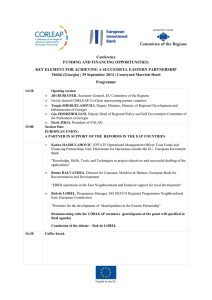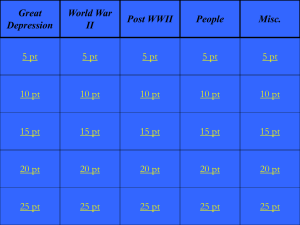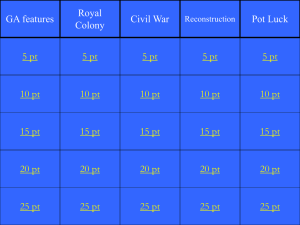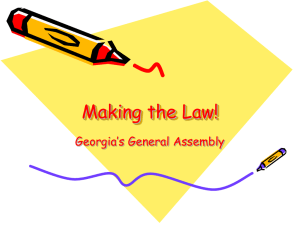Factors dev of Ga AC
advertisement
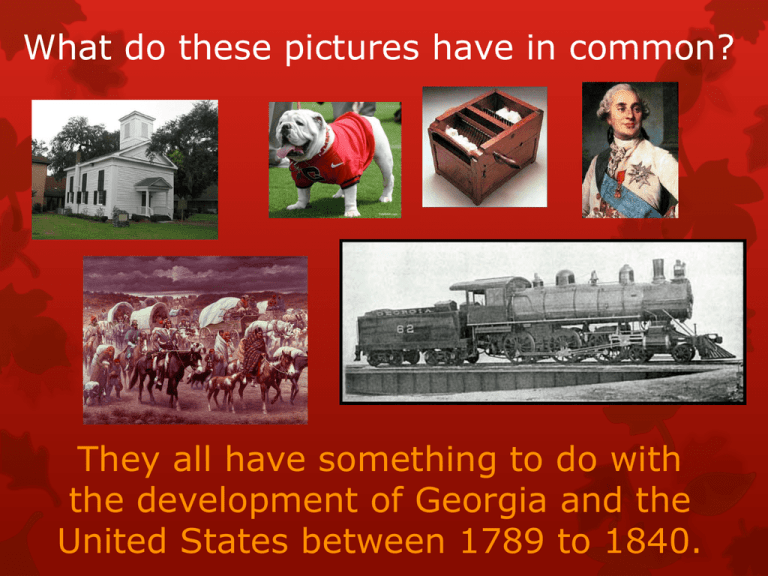
What do these pictures have in common? They all have something to do with the development of Georgia and the United States between 1789 to 1840. Significant factors that affected the development of Georgia 1789 to 1840 The Establishment of the University of Georgia Charter was approved January 27, 1785. First publically supported institute of higher learning in the country. Governor Lyman Hall (signer of the Declaration) chose Abraham Baldwin (signer of the Constitution) to write the Charter. Baldwin was the first president of the University. First students in 1801. Expanded after Civil War. The Establishment of the University of Georgia Main Campus located in Athens (Clarke Countynamed for Elijah Clarke). The Establishment of the University of Georgia Currently have over 34,000 students (undergrad 26,000 and graduate 8,000) More than 600 student organizations Schools and Colleges Arts and Sciences Business Ecology Education Environment and Design Veterinary Medicine Forest Resources Law Pharmacy Public Health Public and International Affairs Social Work Engineering Graduate School Journalism and Mass Communication Agricultural and Environmental Sciences the GRU/UGA Medical Partnership Family and Consumer Sciences The Establishment of the University of Georgia Nickname: UGA Football Team: The Georgia Bulldogs Sanford Stadium Between the Hedges The Capitals of Georgia #1 Savannah #2 Augusta #3 Louisville Atlanta Augusta #4 Milledgeville #5 Atlanta SALMA Louisville Milledgeville Savannah Louisville #3 Named for Louis XVI for his support during the American Revolution. Capital was moved here because, at the time, this was the geographic center of Georgia’s population as settlers moved west. On the Ogeechee River. Malaria outbreaks and population moving further west caused the capital to move to Milledgeville. The Methodists and Baptists Both Protestant churches grew rapidly in Georgia. By the 1830’s these became the largest in the state. The Methodists and Baptists Both used all day revivals and camp meetings to gain followers. Became a place for worship and socializing as people travelled from their farms and small towns. Methodists also used circuit riders, ministers who traveled from town to town. Land Policies After the Revolutionary War, Georgia claimed land to the Mississippi River. Had to decide how to give the lands to the people. Headright System Soldiers from the Revolutionary War received land (including Austin Dabney). White men over the age of 21 who were heads of households could receive up to 200 acres of land. If the man had a family or slaves he could get more. Yazoo Land Fraud Land was sold to companies for a small price. Company had bribed Georgia legislators to get the price low. When people found out, honest legislators burned the documents using a magnifying glass. Land Lottery 1805-1833 Those who wanted land had to buy a ticket. Winner’s names were pulled out of a drum. Land was given to 100,000 families. Cotton Gin Cotton had been deseeded and cleaned by hand. One person could do one pound per day. Eli Whitney created the Cotton Gin, and 50 pounds could be cleaned per day. http://www.youtube.com/watch?feature=player_embedded&v=6eT4bNxkv-c Cotton Gin Cotton became the most profitable crop grown in the South. Led to a greater need for slaves in the South. Railroads Railroads spread through Georgia as a way to get cotton to the coast to be sold around the world. Many towns and cities were created along the rail lines. Atlanta began as a small hub called “Terminus”. The name changed to Marthasville, then to Atlanta. Westward Expansion Manifest Destiny





